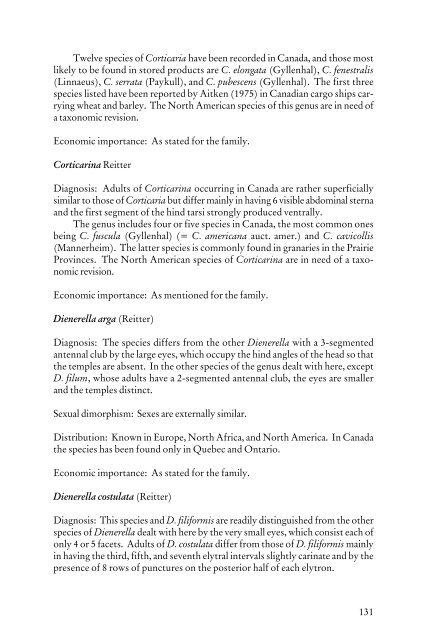Beetles Identification Guide
Beetles Identification Guide
Beetles Identification Guide
Create successful ePaper yourself
Turn your PDF publications into a flip-book with our unique Google optimized e-Paper software.
Twelve species of Corticaria have been recorded in Canada, and those most<br />
likely to be found in stored products are C. elongata (Gyllenhal), C. fenestralis<br />
(Linnaeus), C. serrata (Paykull), and C. pubescens (Gyllenhal). The first three<br />
species listed have been reported by Aitken (1975) in Canadian cargo ships carrying<br />
wheat and barley. The North American species of this genus are in need of<br />
a taxonomic revision.<br />
Economic importance: As stated for the family.<br />
Corticarina Reitter<br />
Diagnosis: Adults of Corticarina occurring in Canada are rather superficially<br />
similar to those of Corticaria but differ mainly in having 6 visible abdominal sterna<br />
and the first segment of the hind tarsi strongly produced ventrally.<br />
The genus includes four or five species in Canada, the most common ones<br />
being C. fuscula (Gyllenhal) (= C. americana auct. amer.) and C. cavicollis<br />
(Mannerheim). The latter species is commonly found in granaries in the Prairie<br />
Provinces. The North American species of Corticarina are in need of a taxonomic<br />
revision.<br />
Economic importance: As mentioned for the family.<br />
Dienerella arga (Reitter)<br />
Diagnosis: The species differs from the other Dienerella with a 3-segmented<br />
antennal club by the large eyes, which occupy the hind angles of the head so that<br />
the temples are absent. In the other species of the genus dealt with here, except<br />
D. filum, whose adults have a 2-segmented antennal club, the eyes are smaller<br />
and the temples distinct.<br />
Sexual dimorphism: Sexes are externally similar.<br />
Distribution: Known in Europe, North Africa, and North America. In Canada<br />
the species has been found only in Quebec and Ontario.<br />
Economic importance: As stated for the family.<br />
Dienerella costulata (Reitter)<br />
Diagnosis: This species and D. filiformis are readily distinguished from the other<br />
species of Dienerella dealt with here by the very small eyes, which consist each of<br />
only 4 or 5 facets. Adults of D. costulata differ from those of D. filiformis mainly<br />
in having the third, fifth, and seventh elytral intervals slightly carinate and by the<br />
presence of 8 rows of punctures on the posterior half of each elytron.<br />
131
















